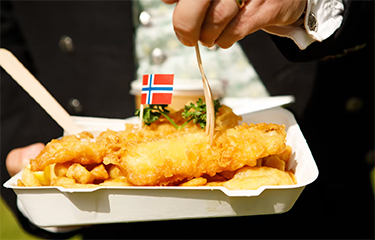Norway exported NOK 13.1 billion (USD 1.8 billion, EUR 1.7 billion) worth of seafood in May 2023, an increase of NOK 816 million (USD 117 million, EUR 109 million) over May 2022.
Norwegian Seafood Council CEO Christian Chramer said the increase in value was largely a result of a weaker Norwegian kroner. If the export value is measured in euros, according to the NSC, the export value actually fell 8 percent, and if measured in U.S. dollars, it fell by 5 percent.
“As in April, we also see a significant currency effect in May,” Chramer said. “The weak Norwegian krone alone contributed to an increase in export value of around NOK 1.5 billion [USD 215 million, EUR 201 million] last month. Without this currency development, there would have been a decline in export value.”
Chramer said the market situation "has now become more demanding” as Norway's monthly exports in May were the weakest thus far in 2023 if measured in euros, despite being the second-best when measured in kroner.
Europe remained the top destination for Norwegian seafood exports, accounting for 68 percent of thethe total. However, sales to Asia and North America increased in May, accounting for 21 percent and 9 percent of sales, respectively.
“We are seeing a shift in total Norwegian seafood exports from Europe to overseas markets such as Asia and North America,” Chramer said.
Food inflation in Europe remains high despite overall inflation decreasing in many markets, Chramer said. Economic growth in the Eurozone is expected to be weaker than the growth in the U.S. and Norway’s largest markets in Asia, he added.
“In Europe, Germany is already in recession, while in France, households' inflation-adjusted purchases of food fell in April to the lowest level since 2009,” Chramer said.
As a result, consumers in Europe are changing their purchasing habits in patterns that mirror how U.S. consumers’ inclinations are also changing.
“In recent months, we have seen a fall in the total home consumption of salmon, cod, and [other] seafood in all major European seafood markets,” Chramer said.
Sales of salmon, which makes up a significant portion of Norway’s exports to the E.U., are falling across Europe, according to NSC Seafood Analyst Paul T. Aandahl.
“In the most-important market for Norwegian salmon, the E.U., we see that the growth trend has reversed,” Aandahl said. “One example of this is fresh whole salmon to the E.U. There, the export volume fell by 6 percent in May, to 44,874 [metric] tons, while the price measured in euros fell by 4 percent"
Sales to the U.S., on the other hand, have increased. Norway exported seafood worth NOK 251 million (USD 36 million, EUR 33 million) more product to the U.S. in May 2023 than it did in May 2022, and volumes sold also increased by 16 percent to 8,345 metric tons (MT).
Additionally, the Chinese market is growing in importance to Norway. China purchased 3,297 MT of Norwegian salmon in May 2023, up 86 percent from May 2022.
“In 2022, May was marked by a full shutdown in Shanghai and, in general, a lot of uncertainty in the market around the corona pandemic. Since the turn of the year, the reopening in China has created a strong demand for salmon that has persisted,” NSC Envoy to China Andreas Thorud said.
Other species also bucked the export value trend. May was the best month ever for king crab exports from Norway, with increased landings and exports.
"Increased landings have resulted in increased exports of both frozen and live king crab of 53 and 45 tons, respectively,” NSC Shellfish Manager Josefine Voraa said.
The U.S. was the top market for both live and frozen crab in the month, with exports of both types reaching 51 MT in total – 150 percent higher than in May 2022.
“Growth has come primarily from increased exports of frozen goods, as there is starting to be less and less Russian king crab available in stock,” Coraa said.
Photo courtesy of the Norwegian Seafood Council.







